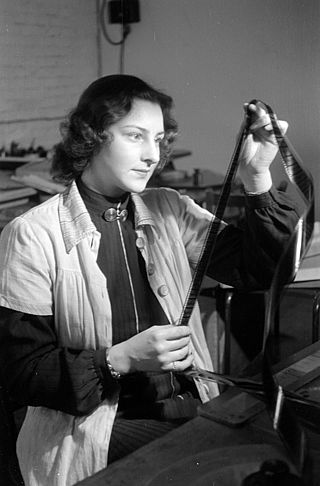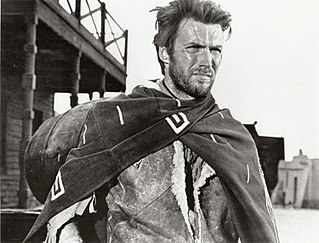
Film editing is both a creative and a technical part of the post-production process of filmmaking. The term is derived from the traditional process of working with film which increasingly involves the use of digital technology. When putting together some sort of video composition, typically, you would need a collection of shots and footages that vary from one another. The act of adjusting the shots you have already taken, and turning them into something new is known as film editing.

A film genre is a stylistic or thematic category for motion pictures based on similarities either in the narrative elements, aesthetic approach, or the emotional response to the film.

A storyboard is a graphic organizer that consists of illustrations or images displayed in sequence for the purpose of pre-visualizing a motion picture, animation, motion graphic or interactive media sequence. The storyboarding process, in the form it is known today, was developed at Walt Disney Productions during the early 1930s, after several years of similar processes being in use at Walt Disney and other animation studios.

The Great Train Robbery is a 1903 American silent film made by Edwin S. Porter for the Edison Manufacturing Company. It follows a gang of outlaws who hold up and rob a steam train at a station in the American West, flee across mountainous terrain, and are finally defeated by a posse of locals. The short film draws on many sources, including a robust existing tradition of Western films, recent European innovations in film technique, the play of the same name by Scott Marble, the popularity of train-themed films, and possibly real-life incidents involving outlaws such as Butch Cassidy.

In a literary work, film, or other narrative, the plot is the sequence of events in which each event affects the next one through the principle of cause-and-effect. The causal events of a plot can be thought of as a series of events linked by the connector "and so". Plots can vary from the simple—such as in a traditional ballad—to forming complex interwoven structures, with each part sometimes referred to as a subplot or imbroglio.
A screenplay, or script, is a written work produced for a film, television show, or video game by screenwriters. A screenplay written for television is also known as a teleplay. Screenplays can be original works or adaptations from existing pieces of writing. A screenplay is a form of narration in which the movements, actions, expressions and dialogue of the characters are described in a certain format. Visual or cinematographic cues may be given, as well as scene descriptions and scene changes.
Story structure or narrative structure is the recognizable or comprehensible way in which a narrative's different elements are unified, including in a particularly chosen order and sometimes specifically referring to the ordering of the plot: the narrative series of events, though this can vary based on culture. In a play or work of theatre especially, this can be called dramatic structure, which is presented in audiovisual form. Story structure can vary by culture and by location. The following is an overview of various story structures and components that might be considered.
A frame story is a literary technique that serves as a companion piece to a story within a story, where an introductory or main narrative sets the stage either for a more emphasized second narrative or for a set of shorter stories. The frame story leads readers from a first story into one or more other stories within it. The frame story may also be used to inform readers about aspects of the secondary narrative(s) that may otherwise be hard to understand. This should not be confused with narrative structure. A notable example is The Decameron.
Cross-cutting is an editing technique most often used in films to establish action occurring at the same time, and often in the same place. In a cross-cut, the camera will cut away from one action to another action, which can suggest the simultaneity of these two actions but this is not always the case. Cross-cutting can also be used for characters in a film with the same goals but different ways of achieving them.

Principal photography is the phase of producing a film or television show in which the bulk of shooting takes place, as distinct from the phases of pre-production and post-production.

Screenwriting or scriptwriting is the art and craft of writing scripts for mass media such as feature films, television productions or video games. It is often a freelance profession.
An act is a major division of a theatre work, including a play, film, opera, ballet, or musical theatre, consisting of one or more scenes. The term can either refer to a conscious division placed within a work by a playwright or a unit of analysis for dividing a dramatic work into sequences. The word act can also be used for major sections of other entertainment, such as variety shows, television programs, music hall performances, cabaret, and literature.
A scene is a dramatic part of a story, at a specific time and place, between specific characters. The term is used in both filmmaking and theatre, with some distinctions between the two.
A shooting script is the version of a screenplay used during the production of a film or video. It provides a plan for what footage to shoot to help tell the story.
A deleted scene is footage that has been removed from the final version of a film or television show. There are various reasons why these scenes are deleted, which include time constraints, relevance, quality or a dropped story thread, and can also be due to budgetary concerns. A similar occurrence is offscreen, in which the events are unseen.
In filmmaking, a beat is a small amount of action resulting in a pause in dialogue. Beats usually involve physical gestures like a character walking to a window or removing their glasses and rubbing their eyes. Short passages of internal monologue can also be considered a sort of internal beat. Beats are also known as "stage business".

Soviet montage theory is an approach to understanding and creating cinema that relies heavily upon editing. It is the principal contribution of Soviet film theorists to global cinema, and brought formalism to bear on filmmaking.
Screenwriting software are word processors specialized to the task of writing screenplays.

Sophocles was a Windows-based screenwriting software application used for writing feature film and television screenplays. The program first became available on the Internet in 1999. Its distinguishing features included a two window screen setup, showing the script and screenplay outline simultaneously.
The three-act structure is a model used in narrative fiction that divides a story into three parts (acts), often called the Setup, the Confrontation, and the Resolution. It was popularized by Syd Field in his 1979 book Screenplay: The Foundations of Screenwriting. Based on his recommendation that a play have a "beginning, middle, and end," the structure has been falsely attributed to Aristotle, who in fact argued for a two-act structure consisting of a "complication" and "dénouement" split by a peripeteia.








